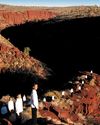
From the time early humans began daubing pictures of woolly mammoths on cave walls, art has remained a relatively simple business: someone creates it, someone buys it and the rest of us get to see it in galleries or museums. For decades, there have been long queues for Leonardo’s Mona Lisa in Paris and Michelangelo’s David in Florence because the best way to truly appreciate these works is to turn up in person.
Not anymore. A revolution is sweeping the art world, up-ending centuries of cosy coexistence between dealers and collectors. In March this year, Christie’s – the venerable, 255-year-old London auction house – achieved the third-highest price ever paid for a work by a living artist. The winning bid of almost US$70 million was for a digital collage called Everydays: The First 5000 Days. The artist was a 39-year-old graphic designer known as Beeple. Contacted at his modest suburban home in the US state of South Carolina, Beeple’s reaction was: “This is too goddamn awesome, man.”
Welcome to the world of crypto art. For $70 million, you could own a topnotch work by Picasso or Monet, and when the auctioneer’s hammer comes down, have your prize packaged up and delivered to your mansion, yacht or ski lodge, where you can gloat over it being entirely unique and all yours. But anyone can see Beeple’s work exactly as the buyer sees it. It exists only as a sequence of digital files, viewable on a screen, and infinitely replicable. So, why would a buyer spend so much money on something the rest of us can have for free?
The world’s first billionaire artist
هذه القصة مأخوذة من طبعة June 2021 من The Australian Women's Weekly.
ابدأ النسخة التجريبية المجانية من Magzter GOLD لمدة 7 أيام للوصول إلى آلاف القصص المتميزة المنسقة وأكثر من 9,000 مجلة وصحيفة.
بالفعل مشترك ? تسجيل الدخول
هذه القصة مأخوذة من طبعة June 2021 من The Australian Women's Weekly.
ابدأ النسخة التجريبية المجانية من Magzter GOLD لمدة 7 أيام للوصول إلى آلاف القصص المتميزة المنسقة وأكثر من 9,000 مجلة وصحيفة.
بالفعل مشترك? تسجيل الدخول

Maggie's kitchen
Maggie Beer's delicious veg patties - perfect for lunch, dinner or a snack - plus a simple nostalgic pudding with fresh passionfruit.

Reclaim your brain
Attention span short? Thoughts foggy? Memory full of gaps? Brigid Moss investigates the latest ways to sharpen your thinking.

The girls from Oz
Melbourne music teacher Judith Curphey challenged the patriarchy when she started Australia's first all-girls choir. Forty years later that bold vision has 6500 members, life-changing programs and a new branch of the sisterhood in Singapore.

One kid can change the world
In 2018, 10-year-old Jack Berne started A Fiver for a Farmer to raise funds for drought relief. He and mum Prue share what happened next.

AFTER THE WAVE
Twenty years ago, the Boxing Day tsunami tore across the Indian Ocean, shredding towns, villages and holiday resorts, and killing hundreds of thousands of people from Indonesia to Africa. Three Australians share their memories of terror, loss and survival with The Weekly.

PATRICIA KARVELAS How childhood tragedy shaped me
Patricia Karvelas hustled hard to chase her dreams, but it wasn't easy. In a deeply personal interview, the ABC host talks about family loss, finding love, battles fought and motherhood.

Ripe for the picking
Buy a kilo or two of fresh Australian apricots because they're at their peak sweetness now and take inspiration from our lush recipe ideas that showcase this divine stone fruit.

Your stars for 2025
The Weekly’s astrologer, Lilith Rocha, reveals what’s in store for your astrological sign in 2025. For your monthly horoscope, turn to page 192.

MEL SCHILLING Cancer made me look at myself differently'
One year on from going public with her bowel cancer diagnosis, Mel Schilling reveals where she's at with her health journey and how it's changed her irrevocably.

Nothing like this Dame Judi
A few weeks before her 90th birthday, the acting legend jumped on a phone call with The Weekly to talk about her extraordinary life – and what’s still to come.